Clinical Practice Report: Risk Factors and Interventions
VerifiedAdded on 2023/06/07
|5
|1262
|477
Report
AI Summary
This report presents a clinical analysis of an 81-year-old patient, Mr. John Ferguson, who experienced a fall. It identifies key risk factors, including advanced age, COPD, knee pain, and hypertension, which contribute to the patient's vulnerability to falls. The report details the desired goal of reducing the frequency and severity of falls, outlining a two-month intervention plan. The interventions include recommending assistive devices like wheelchairs, walkers, and shower chairs, alongside family-implemented safety measures such as proper lighting, even flooring, and grab bars. The report further employs a SBAR (Situation, Background, Assessment, Recommendation) framework to document the patient's condition, history, and the interventions provided, including first aid and prescribed antibiotics. The patient's progress is noted, with a focus on the ongoing need for pain management and continued support to prevent future falls. The report references relevant studies to support the interventions and risk factor analysis.
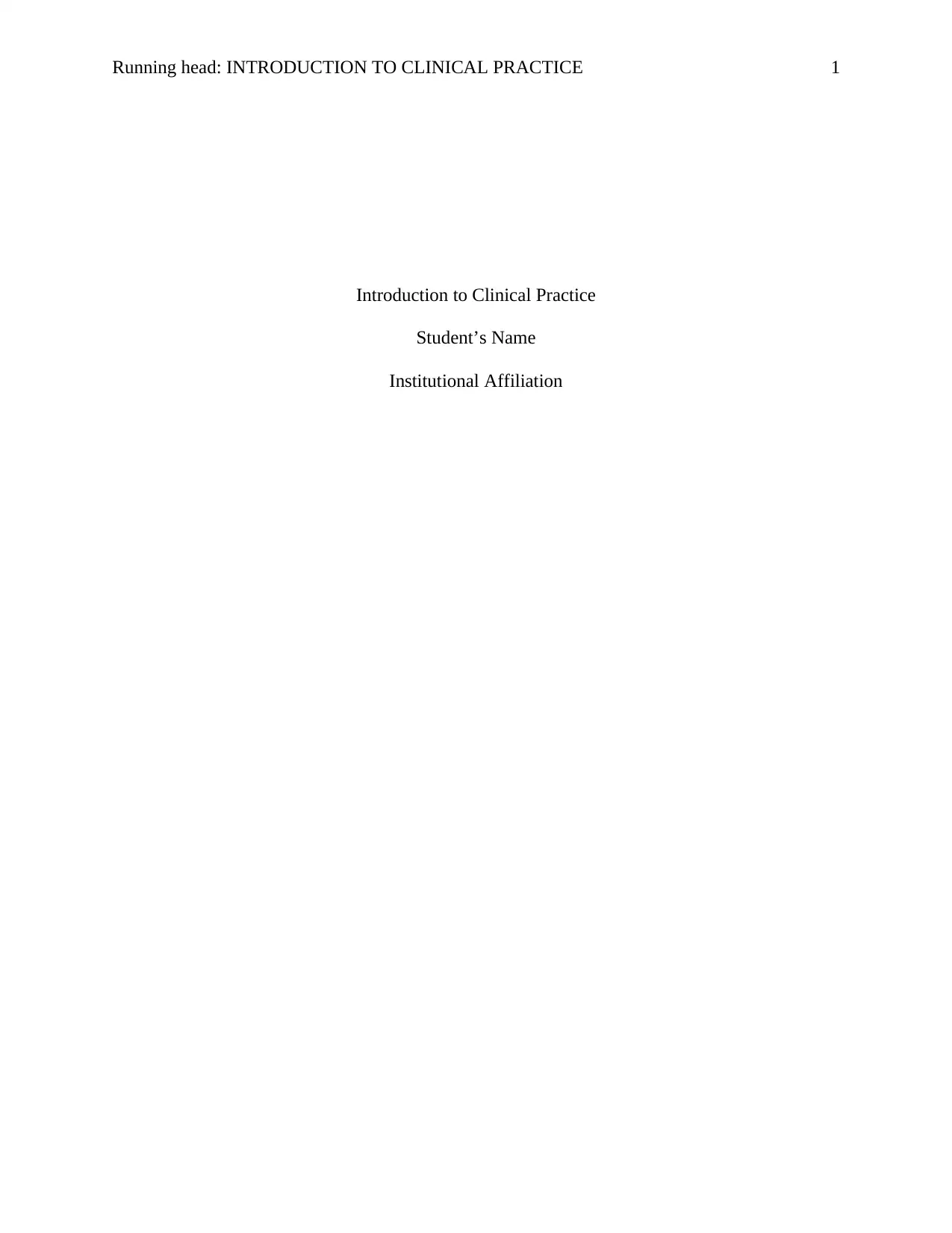
Running head: INTRODUCTION TO CLINICAL PRACTICE 1
Introduction to Clinical Practice
Student’s Name
Institutional Affiliation
Introduction to Clinical Practice
Student’s Name
Institutional Affiliation
Paraphrase This Document
Need a fresh take? Get an instant paraphrase of this document with our AI Paraphraser
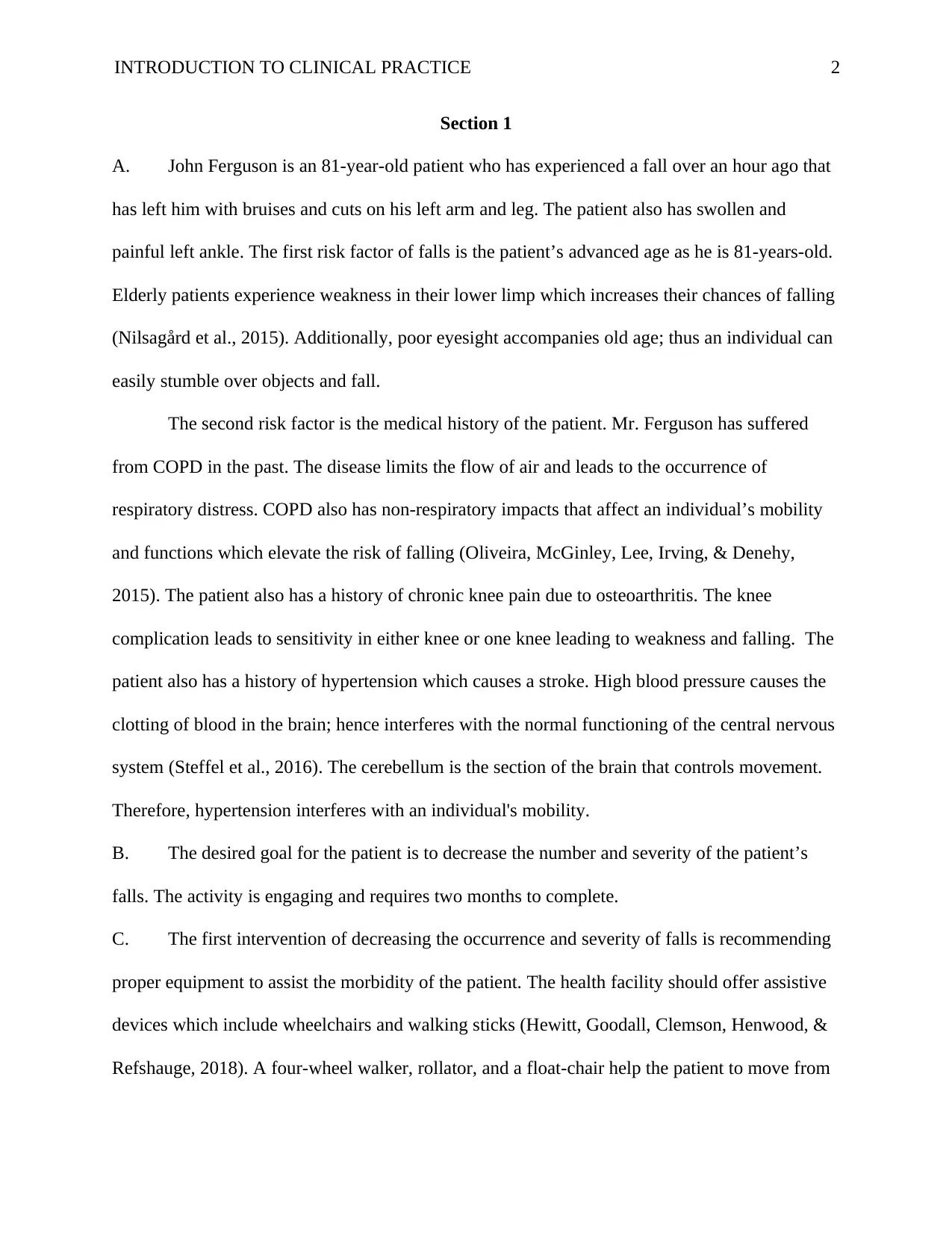
INTRODUCTION TO CLINICAL PRACTICE 2
Section 1
A. John Ferguson is an 81-year-old patient who has experienced a fall over an hour ago that
has left him with bruises and cuts on his left arm and leg. The patient also has swollen and
painful left ankle. The first risk factor of falls is the patient’s advanced age as he is 81-years-old.
Elderly patients experience weakness in their lower limp which increases their chances of falling
(Nilsagård et al., 2015). Additionally, poor eyesight accompanies old age; thus an individual can
easily stumble over objects and fall.
The second risk factor is the medical history of the patient. Mr. Ferguson has suffered
from COPD in the past. The disease limits the flow of air and leads to the occurrence of
respiratory distress. COPD also has non-respiratory impacts that affect an individual’s mobility
and functions which elevate the risk of falling (Oliveira, McGinley, Lee, Irving, & Denehy,
2015). The patient also has a history of chronic knee pain due to osteoarthritis. The knee
complication leads to sensitivity in either knee or one knee leading to weakness and falling. The
patient also has a history of hypertension which causes a stroke. High blood pressure causes the
clotting of blood in the brain; hence interferes with the normal functioning of the central nervous
system (Steffel et al., 2016). The cerebellum is the section of the brain that controls movement.
Therefore, hypertension interferes with an individual's mobility.
B. The desired goal for the patient is to decrease the number and severity of the patient’s
falls. The activity is engaging and requires two months to complete.
C. The first intervention of decreasing the occurrence and severity of falls is recommending
proper equipment to assist the morbidity of the patient. The health facility should offer assistive
devices which include wheelchairs and walking sticks (Hewitt, Goodall, Clemson, Henwood, &
Refshauge, 2018). A four-wheel walker, rollator, and a float-chair help the patient to move from
Section 1
A. John Ferguson is an 81-year-old patient who has experienced a fall over an hour ago that
has left him with bruises and cuts on his left arm and leg. The patient also has swollen and
painful left ankle. The first risk factor of falls is the patient’s advanced age as he is 81-years-old.
Elderly patients experience weakness in their lower limp which increases their chances of falling
(Nilsagård et al., 2015). Additionally, poor eyesight accompanies old age; thus an individual can
easily stumble over objects and fall.
The second risk factor is the medical history of the patient. Mr. Ferguson has suffered
from COPD in the past. The disease limits the flow of air and leads to the occurrence of
respiratory distress. COPD also has non-respiratory impacts that affect an individual’s mobility
and functions which elevate the risk of falling (Oliveira, McGinley, Lee, Irving, & Denehy,
2015). The patient also has a history of chronic knee pain due to osteoarthritis. The knee
complication leads to sensitivity in either knee or one knee leading to weakness and falling. The
patient also has a history of hypertension which causes a stroke. High blood pressure causes the
clotting of blood in the brain; hence interferes with the normal functioning of the central nervous
system (Steffel et al., 2016). The cerebellum is the section of the brain that controls movement.
Therefore, hypertension interferes with an individual's mobility.
B. The desired goal for the patient is to decrease the number and severity of the patient’s
falls. The activity is engaging and requires two months to complete.
C. The first intervention of decreasing the occurrence and severity of falls is recommending
proper equipment to assist the morbidity of the patient. The health facility should offer assistive
devices which include wheelchairs and walking sticks (Hewitt, Goodall, Clemson, Henwood, &
Refshauge, 2018). A four-wheel walker, rollator, and a float-chair help the patient to move from
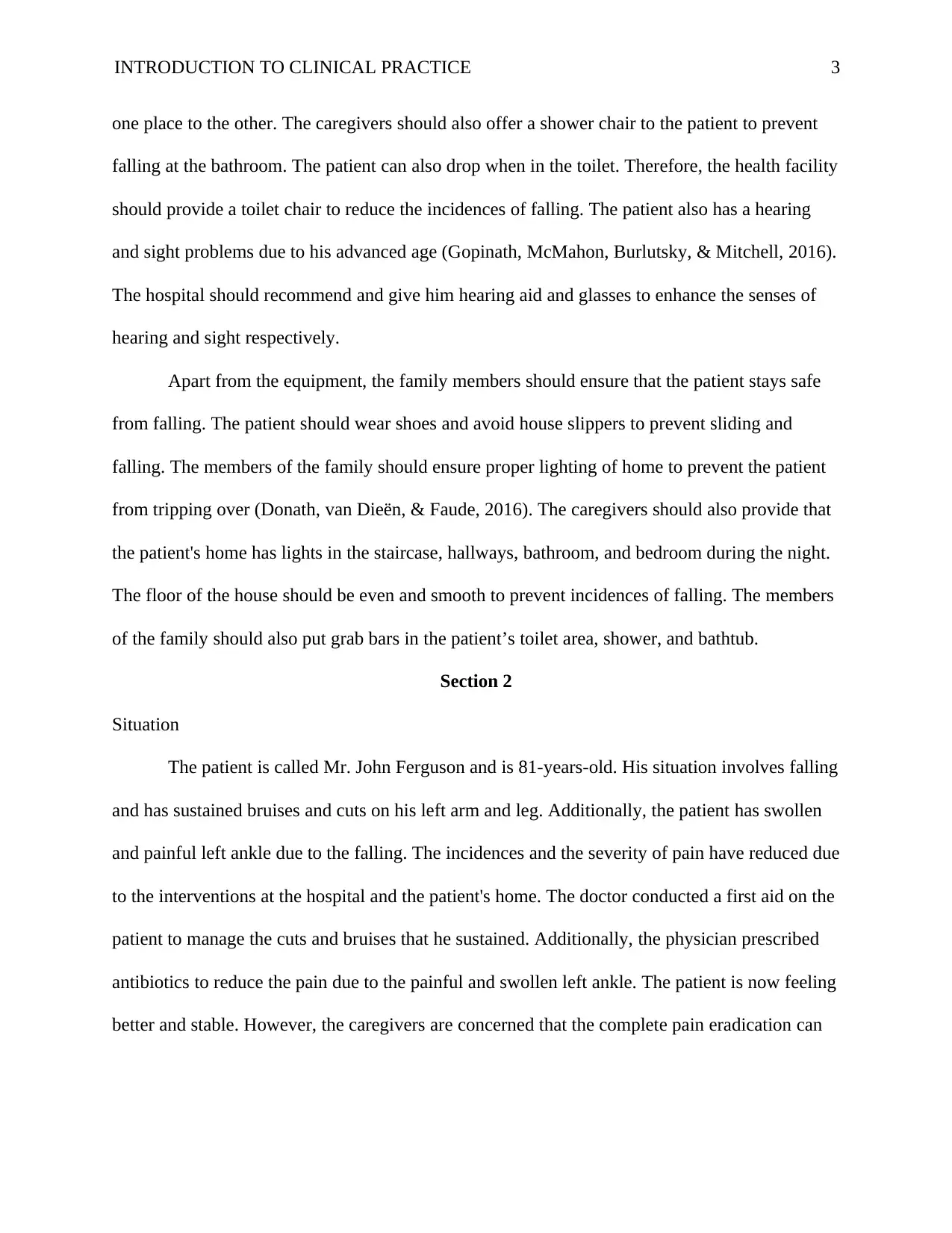
INTRODUCTION TO CLINICAL PRACTICE 3
one place to the other. The caregivers should also offer a shower chair to the patient to prevent
falling at the bathroom. The patient can also drop when in the toilet. Therefore, the health facility
should provide a toilet chair to reduce the incidences of falling. The patient also has a hearing
and sight problems due to his advanced age (Gopinath, McMahon, Burlutsky, & Mitchell, 2016).
The hospital should recommend and give him hearing aid and glasses to enhance the senses of
hearing and sight respectively.
Apart from the equipment, the family members should ensure that the patient stays safe
from falling. The patient should wear shoes and avoid house slippers to prevent sliding and
falling. The members of the family should ensure proper lighting of home to prevent the patient
from tripping over (Donath, van Dieën, & Faude, 2016). The caregivers should also provide that
the patient's home has lights in the staircase, hallways, bathroom, and bedroom during the night.
The floor of the house should be even and smooth to prevent incidences of falling. The members
of the family should also put grab bars in the patient’s toilet area, shower, and bathtub.
Section 2
Situation
The patient is called Mr. John Ferguson and is 81-years-old. His situation involves falling
and has sustained bruises and cuts on his left arm and leg. Additionally, the patient has swollen
and painful left ankle due to the falling. The incidences and the severity of pain have reduced due
to the interventions at the hospital and the patient's home. The doctor conducted a first aid on the
patient to manage the cuts and bruises that he sustained. Additionally, the physician prescribed
antibiotics to reduce the pain due to the painful and swollen left ankle. The patient is now feeling
better and stable. However, the caregivers are concerned that the complete pain eradication can
one place to the other. The caregivers should also offer a shower chair to the patient to prevent
falling at the bathroom. The patient can also drop when in the toilet. Therefore, the health facility
should provide a toilet chair to reduce the incidences of falling. The patient also has a hearing
and sight problems due to his advanced age (Gopinath, McMahon, Burlutsky, & Mitchell, 2016).
The hospital should recommend and give him hearing aid and glasses to enhance the senses of
hearing and sight respectively.
Apart from the equipment, the family members should ensure that the patient stays safe
from falling. The patient should wear shoes and avoid house slippers to prevent sliding and
falling. The members of the family should ensure proper lighting of home to prevent the patient
from tripping over (Donath, van Dieën, & Faude, 2016). The caregivers should also provide that
the patient's home has lights in the staircase, hallways, bathroom, and bedroom during the night.
The floor of the house should be even and smooth to prevent incidences of falling. The members
of the family should also put grab bars in the patient’s toilet area, shower, and bathtub.
Section 2
Situation
The patient is called Mr. John Ferguson and is 81-years-old. His situation involves falling
and has sustained bruises and cuts on his left arm and leg. Additionally, the patient has swollen
and painful left ankle due to the falling. The incidences and the severity of pain have reduced due
to the interventions at the hospital and the patient's home. The doctor conducted a first aid on the
patient to manage the cuts and bruises that he sustained. Additionally, the physician prescribed
antibiotics to reduce the pain due to the painful and swollen left ankle. The patient is now feeling
better and stable. However, the caregivers are concerned that the complete pain eradication can
⊘ This is a preview!⊘
Do you want full access?
Subscribe today to unlock all pages.

Trusted by 1+ million students worldwide
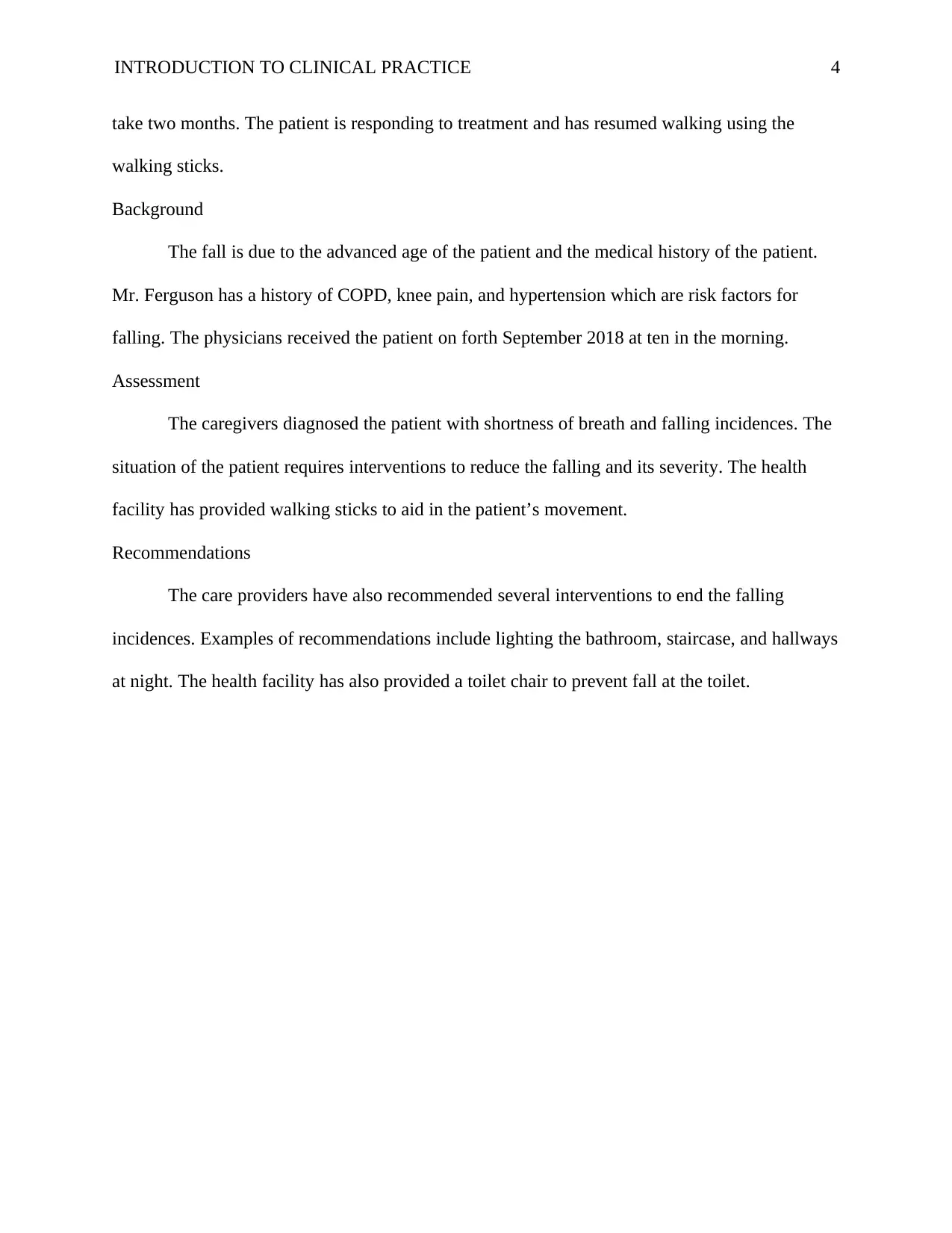
INTRODUCTION TO CLINICAL PRACTICE 4
take two months. The patient is responding to treatment and has resumed walking using the
walking sticks.
Background
The fall is due to the advanced age of the patient and the medical history of the patient.
Mr. Ferguson has a history of COPD, knee pain, and hypertension which are risk factors for
falling. The physicians received the patient on forth September 2018 at ten in the morning.
Assessment
The caregivers diagnosed the patient with shortness of breath and falling incidences. The
situation of the patient requires interventions to reduce the falling and its severity. The health
facility has provided walking sticks to aid in the patient’s movement.
Recommendations
The care providers have also recommended several interventions to end the falling
incidences. Examples of recommendations include lighting the bathroom, staircase, and hallways
at night. The health facility has also provided a toilet chair to prevent fall at the toilet.
take two months. The patient is responding to treatment and has resumed walking using the
walking sticks.
Background
The fall is due to the advanced age of the patient and the medical history of the patient.
Mr. Ferguson has a history of COPD, knee pain, and hypertension which are risk factors for
falling. The physicians received the patient on forth September 2018 at ten in the morning.
Assessment
The caregivers diagnosed the patient with shortness of breath and falling incidences. The
situation of the patient requires interventions to reduce the falling and its severity. The health
facility has provided walking sticks to aid in the patient’s movement.
Recommendations
The care providers have also recommended several interventions to end the falling
incidences. Examples of recommendations include lighting the bathroom, staircase, and hallways
at night. The health facility has also provided a toilet chair to prevent fall at the toilet.
Paraphrase This Document
Need a fresh take? Get an instant paraphrase of this document with our AI Paraphraser
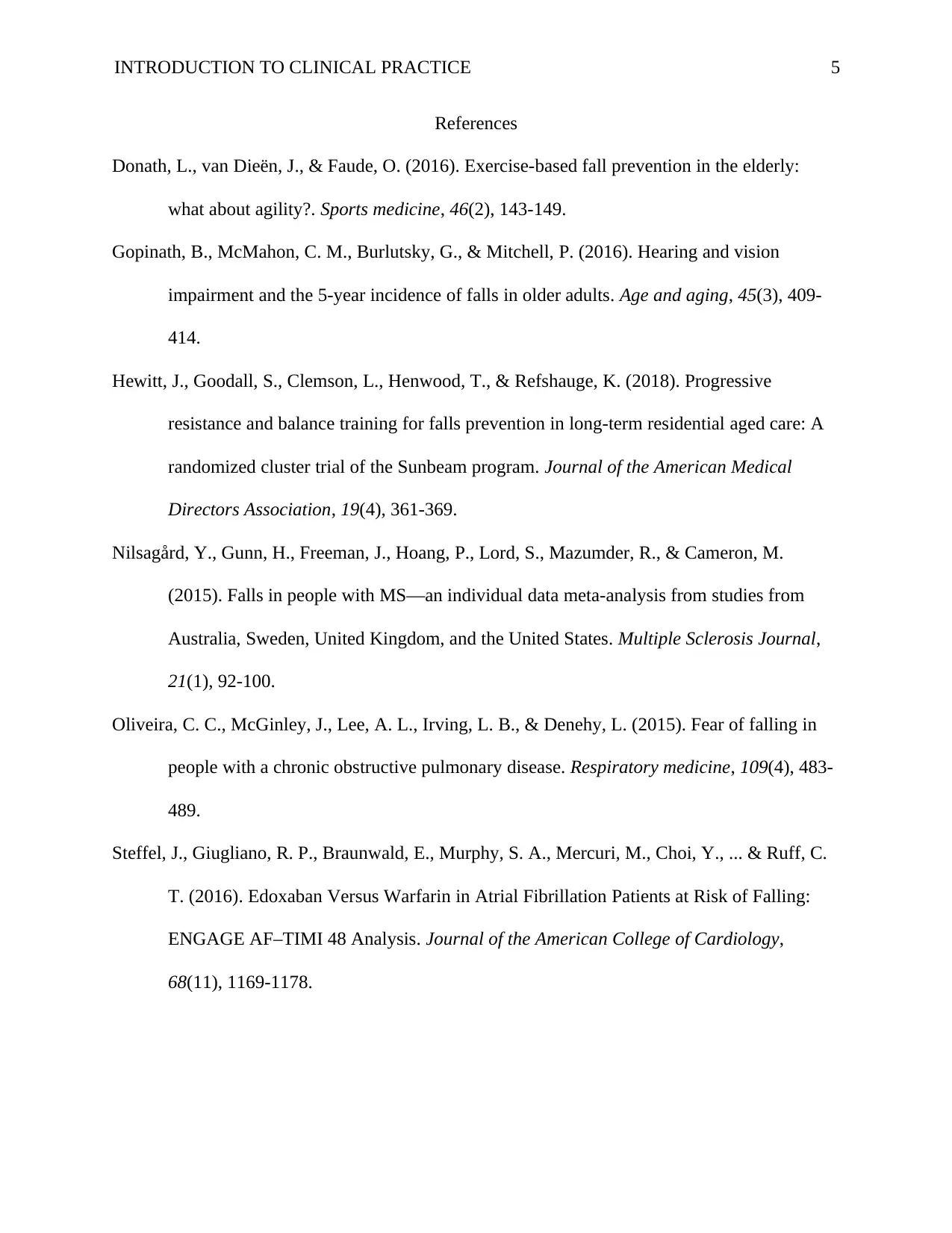
INTRODUCTION TO CLINICAL PRACTICE 5
References
Donath, L., van Dieën, J., & Faude, O. (2016). Exercise-based fall prevention in the elderly:
what about agility?. Sports medicine, 46(2), 143-149.
Gopinath, B., McMahon, C. M., Burlutsky, G., & Mitchell, P. (2016). Hearing and vision
impairment and the 5-year incidence of falls in older adults. Age and aging, 45(3), 409-
414.
Hewitt, J., Goodall, S., Clemson, L., Henwood, T., & Refshauge, K. (2018). Progressive
resistance and balance training for falls prevention in long-term residential aged care: A
randomized cluster trial of the Sunbeam program. Journal of the American Medical
Directors Association, 19(4), 361-369.
Nilsagård, Y., Gunn, H., Freeman, J., Hoang, P., Lord, S., Mazumder, R., & Cameron, M.
(2015). Falls in people with MS—an individual data meta-analysis from studies from
Australia, Sweden, United Kingdom, and the United States. Multiple Sclerosis Journal,
21(1), 92-100.
Oliveira, C. C., McGinley, J., Lee, A. L., Irving, L. B., & Denehy, L. (2015). Fear of falling in
people with a chronic obstructive pulmonary disease. Respiratory medicine, 109(4), 483-
489.
Steffel, J., Giugliano, R. P., Braunwald, E., Murphy, S. A., Mercuri, M., Choi, Y., ... & Ruff, C.
T. (2016). Edoxaban Versus Warfarin in Atrial Fibrillation Patients at Risk of Falling:
ENGAGE AF–TIMI 48 Analysis. Journal of the American College of Cardiology,
68(11), 1169-1178.
References
Donath, L., van Dieën, J., & Faude, O. (2016). Exercise-based fall prevention in the elderly:
what about agility?. Sports medicine, 46(2), 143-149.
Gopinath, B., McMahon, C. M., Burlutsky, G., & Mitchell, P. (2016). Hearing and vision
impairment and the 5-year incidence of falls in older adults. Age and aging, 45(3), 409-
414.
Hewitt, J., Goodall, S., Clemson, L., Henwood, T., & Refshauge, K. (2018). Progressive
resistance and balance training for falls prevention in long-term residential aged care: A
randomized cluster trial of the Sunbeam program. Journal of the American Medical
Directors Association, 19(4), 361-369.
Nilsagård, Y., Gunn, H., Freeman, J., Hoang, P., Lord, S., Mazumder, R., & Cameron, M.
(2015). Falls in people with MS—an individual data meta-analysis from studies from
Australia, Sweden, United Kingdom, and the United States. Multiple Sclerosis Journal,
21(1), 92-100.
Oliveira, C. C., McGinley, J., Lee, A. L., Irving, L. B., & Denehy, L. (2015). Fear of falling in
people with a chronic obstructive pulmonary disease. Respiratory medicine, 109(4), 483-
489.
Steffel, J., Giugliano, R. P., Braunwald, E., Murphy, S. A., Mercuri, M., Choi, Y., ... & Ruff, C.
T. (2016). Edoxaban Versus Warfarin in Atrial Fibrillation Patients at Risk of Falling:
ENGAGE AF–TIMI 48 Analysis. Journal of the American College of Cardiology,
68(11), 1169-1178.
1 out of 5
Related Documents
Your All-in-One AI-Powered Toolkit for Academic Success.
+13062052269
info@desklib.com
Available 24*7 on WhatsApp / Email
![[object Object]](/_next/static/media/star-bottom.7253800d.svg)
Unlock your academic potential
Copyright © 2020–2025 A2Z Services. All Rights Reserved. Developed and managed by ZUCOL.




